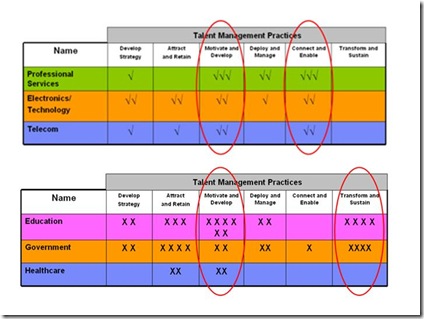 I attended another Human Capital Institute webinar on Thursday, outlining their joint research with IBM's Institute for Business Value into six key practices of talent management: strategy development, attracting and retaining, motivating and developing, deploying and managing, connecting and enabling, and transforming and sustaining.
I attended another Human Capital Institute webinar on Thursday, outlining their joint research with IBM's Institute for Business Value into six key practices of talent management: strategy development, attracting and retaining, motivating and developing, deploying and managing, connecting and enabling, and transforming and sustaining.
It's an interesting piece of research, although it includes some aspects that I'd challenge, for example, its conclusion that organisations need to develop analytical capabilities which I don't think is supported by the evidence, and a rather broad and unstrategic focus on talent management (one respondent is quoted as saying "We have combined HR and business plans. They are integrated. We have a 5 year planning process. For example, if Operations say that we need to expand heart surgery, then HR is at the table to say that we need more lab technicians, more surgeons and whatever other human capital is needed". This still sounds like being a glorified order taker to me.)
The research has found that:
"Companies with high scores across the board were more likely to have strong financial performance, based on reported change in operating profits between 2003 and 2006.
'It's not the first research to show a correlation between talent management and financial results,' admits Allan Schweyer, executive director of HCI and one of the authors of the report, 'but it's one in a handful, and I think it really adds to that body of evidence that is helping organizations to build a solid business case for investments in talent management'."
I'd agree. In fact the correlation with financial performance wasn't what I found to be the most interesting aspect of the research.
What interested me was the range of performance across size of organisation and particularly across sector in these different aspects of talent management, from professional services and technology firms with relatively well developed processes to financial services which tends to focus on body shopping ("focusing on attraction and retention with little attention paid to employee development, deployment or collaboration") and onto government and education with little to show for themselves in any areas of talent management.
If these organisations are waiting for better evidence linking talent management and organisational results before they do anything, they're going to miss out on some pretty major opportunities for improving their performance while they wait!






























Dear Jon
ReplyDeleteI am Afshin from Iran. I am so happy to found your blog. I am HR professional. 2 years ago I and my colleag translated Dave Ulrich's book: The HR value proposition. I hope I learn more and more by you. I have many questions and I will check them with you one by one!
My blog is about HR but it is in Farsi (Persian)! Sorry! Maybe in future, I set an English version!
Moreover, a request. I searched internet to find a ppt file about your book (Strategic HC) but I didn't find anything. Could you please give me a summary? Is it possible? Many thanks,
Bests
Afshin Dabiri
Hi Afshin,
ReplyDeleteI've got some presentations up under the 'About HCM' of this blog - see http://strategic-hcm.blogspot.com/2007/07/about-hcm.html.
Or I'll shortly (next couple of weeks) be trying to develop a short summary of thinking around strategic HCM with the Human Capital community at http://humancapital.ning.com/ - please join...
I hope I might be able to meet you in Iran one day (I'm in UAE at the moment).
Interesting post about the survey - thanks. I suspect that the successful firms all have a people focused mindset and culture. This can take years to build up and IBM went through a big change some years ago. If IBM can do it......anyone can!
ReplyDeleteChris
http://learn2develop.blogspot.com
Some of the most interesting research I've seen on this topic of the correlation between talent (or happy employees) and financial performance is in the book "Firms of Endearment." The authors uncovered a 1000% increased return over a 10 year period (that's not a typo) for firms beloved by employees, customers, the media, etc., than by S&P 500 or even "Good to Great" firms. I wrote more about it here: http://globoforce.blogspot.com/2008/07/happy-employees-1000-shareholder-return.html
ReplyDeleteThank you very much for link.
ReplyDeleteI will wait to see your summary.
Hope to see you in Iran
Bests